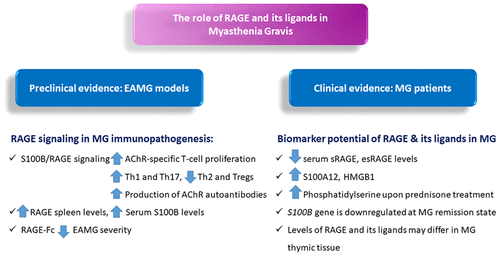当前位置:
X-MOL 学术
›
ACS Chem. Neurosci.
›
论文详情
Our official English website, www.x-mol.net, welcomes your
feedback! (Note: you will need to create a separate account there.)
Unraveling the Role of Receptor for Advanced Glycation End Products (RAGE) and Its Ligands in Myasthenia Gravis.
ACS Chemical Neuroscience ( IF 4.1 ) Pub Date : 2020-02-13 , DOI: 10.1021/acschemneuro.9b00678 Efthalia Angelopoulou 1 , Yam Nath Paudel 2 , Christina Piperi 1
ACS Chemical Neuroscience ( IF 4.1 ) Pub Date : 2020-02-13 , DOI: 10.1021/acschemneuro.9b00678 Efthalia Angelopoulou 1 , Yam Nath Paudel 2 , Christina Piperi 1
Affiliation

|
Myasthenia gravis (MG) is an autoimmune T cell-dependent B cell-mediated disorder of the neuromuscular junction (NMJ) characterized by fluctuating skeletal muscle weakness, most commonly attributed to pathogenic autoantibodies against postsynaptic nicotinic acetylcholine receptors (AChRs). Although MG pathogenesis is well-documented, there are no objective biomarkers that could effectively correlate with disease severity or MG clinical subtypes, and current treatment approaches are often ineffective. The receptor for advanced glycation end products (RAGE) is a multiligand cell-bound receptor highly implicated in proinflammatory responses and autoimmunity. Preclinical evidence demonstrates that RAGE and its ligand S100B are upregulated in rat models of experimental autoimmune myasthenia gravis (EAMG). S100B-mediated RAGE activation has been shown to exacerbate EAMG, by enhancing T cell proinflammatory responses, aggravating T helper (Th) subset imbalance, increasing AChR-specific T cell proliferative capacity, and promoting the production of antibodies against AChRs from the spleen. Soluble sRAGE and esRAGE, acting as decoys of RAGE ligands, are found to be significantly reduced in MG patients. Moreover, MG has been associated with increased serum levels of S100A12, S100B and HMGB1. Several studies have shown that the presence of thymic abnormalities, the onset age of MG, and the duration of the disease may affect the levels of these proteins in MG patients. Herein, we discuss the emerging role of RAGE and its ligands in MG immunopathogenesis, their clinical significance as promising biomarkers, as well as the potential therapeutic implications of targeting RAGE signaling in MG treatment.
中文翻译:

揭示晚期糖基化终产物 (RAGE) 受体及其配体在重症肌无力中的作用。
重症肌无力 (MG) 是一种自身免疫性 T 细胞依赖性 B 细胞介导的神经肌肉接头 (NMJ) 疾病,其特征是波动的骨骼肌无力,最常见的原因是针对突触后烟碱型乙酰胆碱受体 (AChRs) 的致病性自身抗体。尽管 MG 发病机制已得到充分证明,但没有客观的生物标志物可以有效地与疾病严重程度或 MG 临床亚型相关联,目前的治疗方法通常无效。晚期糖基化终产物受体 (RAGE) 是一种多配体细胞结合受体,与促炎反应和自身免疫密切相关。临床前证据表明,RAGE 及其配体 S100B 在实验性自身免疫性重症肌无力 (EAMG) 大鼠模型中上调。S100B 介导的 RAGE 激活通过增强 T 细胞促炎反应、加重 T 辅助细胞 (Th) 亚群失衡、增加 AChR 特异性 T 细胞增殖能力以及促进脾脏中抗 AChR 抗体的产生,已被证明会加剧 EAMG。发现可溶性 sRAGE 和 esRAGE 作为 RAGE 配体的诱饵,在 MG 患者中显着降低。此外,MG 与 S100A12、S100B 和 HMGB1 的血清水平升高有关。多项研究表明,胸腺异常的存在、MG 的发病年龄和病程可能会影响 MG 患者中这些蛋白质的水平。在此,我们讨论了 RAGE 及其配体在 MG 免疫发病机制中的新兴作用,它们作为有前途的生物标志物的临床意义,
更新日期:2020-02-14
中文翻译:

揭示晚期糖基化终产物 (RAGE) 受体及其配体在重症肌无力中的作用。
重症肌无力 (MG) 是一种自身免疫性 T 细胞依赖性 B 细胞介导的神经肌肉接头 (NMJ) 疾病,其特征是波动的骨骼肌无力,最常见的原因是针对突触后烟碱型乙酰胆碱受体 (AChRs) 的致病性自身抗体。尽管 MG 发病机制已得到充分证明,但没有客观的生物标志物可以有效地与疾病严重程度或 MG 临床亚型相关联,目前的治疗方法通常无效。晚期糖基化终产物受体 (RAGE) 是一种多配体细胞结合受体,与促炎反应和自身免疫密切相关。临床前证据表明,RAGE 及其配体 S100B 在实验性自身免疫性重症肌无力 (EAMG) 大鼠模型中上调。S100B 介导的 RAGE 激活通过增强 T 细胞促炎反应、加重 T 辅助细胞 (Th) 亚群失衡、增加 AChR 特异性 T 细胞增殖能力以及促进脾脏中抗 AChR 抗体的产生,已被证明会加剧 EAMG。发现可溶性 sRAGE 和 esRAGE 作为 RAGE 配体的诱饵,在 MG 患者中显着降低。此外,MG 与 S100A12、S100B 和 HMGB1 的血清水平升高有关。多项研究表明,胸腺异常的存在、MG 的发病年龄和病程可能会影响 MG 患者中这些蛋白质的水平。在此,我们讨论了 RAGE 及其配体在 MG 免疫发病机制中的新兴作用,它们作为有前途的生物标志物的临床意义,











































 京公网安备 11010802027423号
京公网安备 11010802027423号